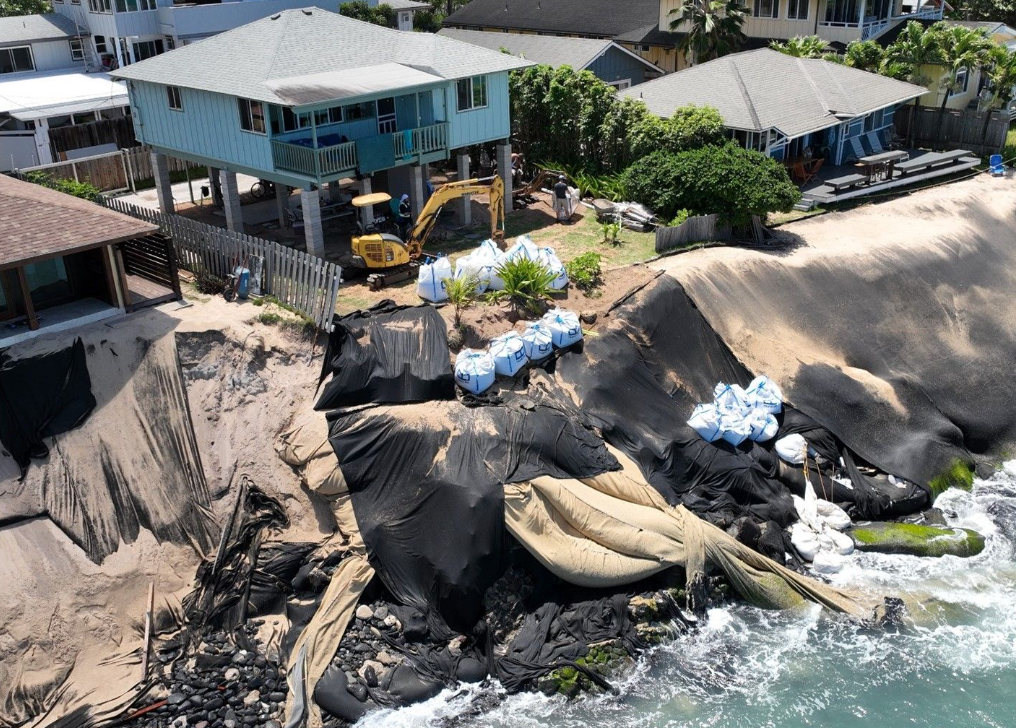09/21/22 – NO GOOD OPTIONS FOR HOMEOWNERS & THE PUBLIC ON O‘AHU’S NORTH SHORE
Posted on Sep 22, 2022 in News Releases, OCCL, slider| DAVID Y. IGE GOVERNOR |
SUZANNE D. CASE
CHAIRPERSON |
For Immediate Release: September 21, 2022
NO GOOD OPTIONS FOR HOMEOWNERS & THE PUBLIC ON O‘AHU’S NORTH SHORE
Office of Conservation & Coastal Lands Seeking Solutions to Ongoing Crisis
To view video please click on photo or view at this link: https://vimeo.com/753666351
(HONOLULU) – The plight of public beaches and twenty homes on dunes above, in the Paumalu ahupua‘a on the north shore of O‘ahu, has consumed Michael Cain and his staff.
This year, after seventeen years with DLNR, Cain was appointed administrator of the DLNR Office of Conservation and Coastal Lands (OCCL). He and his team continue to grapple with what to do about coastal homes with expired, temporary emergency State permits to “shore” up the land under their foundations to stop the forces of erosion from toppling them onto the beach and into the ocean. All the homes at Paumalu border public beaches within a State Conservation District.
“Earlier this month, utilizing a drone, we surveyed the area, and it revealed unpermitted shoreline hardening work continuing at a number of properties, in violation of Conservation District rules,” Cain explained. “This survey shows the enormous scale of the situation we face as regulators, and the desperate and illegal measures some homeowners continue to employ.”
Aerial photography shows some homes teetering on sandy soil just above the beach. Large, sand-filled tubes litter the beach below. Equally large fabric curtains drape the slopes in front of some structures, all the way down to what remains of the public beach. “It’s a real mess and the photographs clearly show it,” Cain says.
“Allowing these structures (erosion control devices) to remain endangers the public beach, limits access to them for much of the year, and is littering the near-shore marine and shoreline environment with debris. They are supposed to be temporary, to give the landowners time to plan for moving their houses and cesspools, which few have done. There could be even greater environmental catastrophe if houses and their cesspools start falling into the ocean. This is a complicated and difficult situation to resolve,” Cain added.
The drone survey led to the creation of a document that details the permit history of each home, outlines the expired erosion control methods still in place, and any past or current enforcement actions. “The current system of bringing enforcement actions to the Board of Land and Natural Resources, working our way through the process for contested cases requested by landowners on alleged violations, and then following up when cases are appealed in court, is slow and inefficient. Unfortunately, this process is the only enforcement tool OCCL currently has available,” Cain explained.
Shorelines are naturally dynamic. Most of our beaches are experiencing chronic erosion. The natural, seasonal cycle of beach widening and narrowing adds to the long-term beach loss. Historically shoreline hardening such as seawalls was the solution to protect homes, but coastal experts now know it destroys beaches. OCCL estimates that more than thirteen miles of beaches have already been lost in Hawai‘i due to erosion and seawalls.
“Many of the structures captured in our drone footage were given emergency permits, allowing landowners to place sandbag tubes on public land to temporarily protect their properties while the landowners worked on a long-term solution for protecting or moving their property,” Cain remarked. “We allege that none of the permit holders at Paumalu have complied with all the conditions of their permits. Their permits have expired, and the sandbag structures have become de facto seawalls that are putting the future of the beach at risk.”
OCCL notes that allowing the erosion control structures to remain creates an unmanaged hazardous situation that endangers public trust resources. Resolving the crisis will take a coordinated effort between all branches of the State and the counties.
Cain concluded, “We’re actively working with county planning departments and State legislators to try and identify solutions. We’re not alone. Coastal communities across the world are facing similar situations. We talk about “retreat,” but no one has successfully implemented retreat in a densely populated area like we have with little room to move inland. We don’t have many role models to follow, and Hawai‘i is going to have to take the lead in finding solutions.”
# # #
RESOURCES
(All images/video courtesy: DLNR)
HD video – Puamalu Erosion Issues (Sept. 21, 2022):
Media Contact:
Dan Dennison
Senior Communications Manager
Hawaii Dept. of Land and Natural Resources
